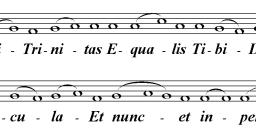Examples of cantus firmus motets
-
Although it is probably not what you are looking for, you might try the Magnificat from Monteverdi's Marian Vespers. In many sections you can hear one voice singing the chant tone while other voices sing around it. It is not traditional polyphony but is does make the point rather well.
https://www.youtube.com/watch?v=E2pcz5fnT_w -
One with a familiar cf that comes immediately to mind is Victoria's Genitori genitoque. The opening section quotes the cantus in the bass. It is readily found in Oxford's A Sixteenth Century Anthem Book.
-
Heinrich Isaac:
Advent I: "Alleluia. Ostende nobis, Domine"
Quasimodo Sunday: Communio: "Mitte manum tuam"
Those probably aren't my favorite, per se, but they popped into my head when I read this.. -
Factus es Repente (from Pentecost), and motet of the same name by Aichinger. Definitely uses some of the melodic pieces of the chant to form his motet.
Regina Caeli (SATB) by Palestrina; Great example of using the simple tone chanted melody in the motet.
Ave Maria (SATB) by Victoria; also uses parts of the chant melody.
The Morales 5-part requiem most definitely has one of the voices singing the chant melodies of the requiem chants as a cantus firmus line. BEAUTIFUL requiem setting it is, too!
I think there are a variety of other motets we sing that probably included pieces of the chant melodies they are based of off... by I can't say we've sung very many that fully use the chant melody, drawn out, in one voice part as a cantus firmus. -
Isaac is a great study for such a subject, just in general, by the way.
-
Or, if you want an explicit CF 'motet' you could consider something like Viderunt ones and the Perotin setting of same.
https://www.youtube.com/watch?v=MI6e4Q11NeM -
Not a favorite of mine, but this is another one with an obvious CF in the Bass: Mozart - Cibavit Eos It might be useful to show what polyphony sounded like in the 18th century.
-
-
The Taverner Missa Gloria tibi Trinitas quotes the chant "Gloria tibi Trinitas" in every movement, usually at a very slow pace, in breves. This is arguably Taverner's greatest musical testament.
John Taverner: Missa Gloria tibi Trinitas - Sanctus & Benedictus

 Gloria_tibi_Trinitas.jpg2028 x 429 - 219KThanked by 1M. Jackson Osborn
Gloria_tibi_Trinitas.jpg2028 x 429 - 219KThanked by 1M. Jackson Osborn -
I love Josquin's Missa Pange Lingua, which has a stunning fugal treatment of the chant that even retains the Mode III--even just the Kyrie is good to study, although it's not a motet.
Durufle's Tota pulchra comes to mind, as well as Palestrina's O crux ave and Victoria's Regina Caeli a 4. -
Thanks, Chuck, for the Taverner reference to the Gloria tibi antiphon. Those who aren't already aware should be interested to know that this antiphon as quoted by Taverner in the in nomine section of Sanctus in this mass is the inspiration for the traditional In nomines and Gloria tibi Trinitases in English organ literature of the Tudor and Stuart eras. Purcell even wrote an In nomine for a consort of viols, as did others. One ever so once in a while encounters a more recent example - but seldom any more. Just several years ago our member, Dr Gregory Hamilton, wrote one for me.Thanked by 1CHGiffen
-
And thank you, Jackson. I'm quite familiar with the tradition of composing In nomine works, derived from the Taverner. When I sang with Zephyrus and performed the Missa Gloria tibi Trinitas both in Charlottesville, Virginia and at St. Matthew's Cathedral in Washington, D.C., I was the bass soloist for the In nomine section (as well as other sections of the mass). Actually, the Gloria tibi Trinitas chant is also heard (in the baritone line) prominently at the beginning of the Benedictus section, just before the In nomine section.
The Gloria tibi Trinitas chant occurs repeatedly (ie. more than once) in every moment.Thanked by 1M. Jackson Osborn
Welcome to the MusicaSacra Forum!
To participate in the discussions on Catholic church music, sign in or register as a forum member, The forum is a project of the Church Music Association of America.
Categories
- All Discussions21,105
- General Music Discussion8,218
- Job Openings197
- Management of Music Programs850
- Choral Matters533
- Church Documents and Rubrics524
- CMAA Notes302
- Events716
- For Newcomers: Read First26
- Sacred Polyphony546
- Hymnody872
- Gregorian Chant: General2,697
- ↳ Graduale Romanum and Liber Usualis368
- ↳ Graduale Simplex60
- ↳ Semiology63
- Vernacular Plainsong696
- Anglican Use and Anglican Chant68
- Organ, Other Instruments and Repertoire435
- New Composition/Works in Progress1,290
- Recordings230
- Music for Hispanic Ministry159
- Music Education: Children211
- Music Education: General222
- News Items245
- Positions Wanted2
- General Discussion: Catholicism739
- Amusements177
- General Discussion1,033
- Opinions117





